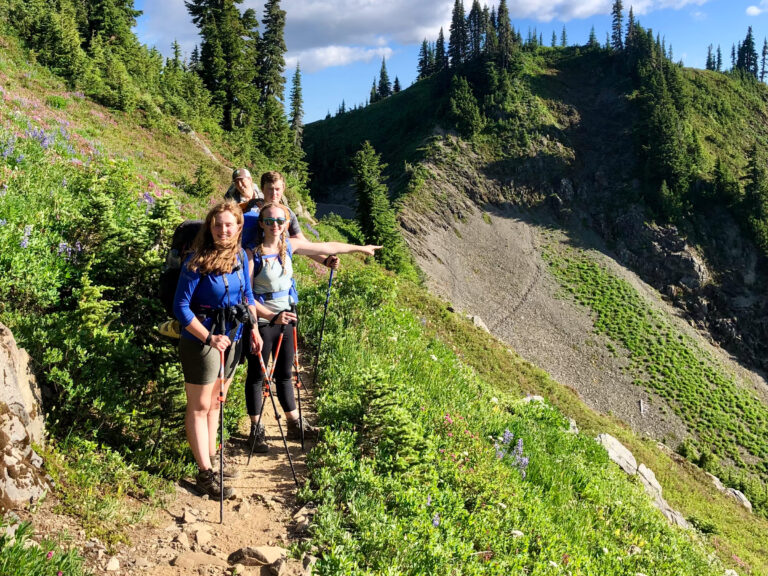Fall is in the air, and while that makes most of us want to curl up next to a cozy fire, it invokes a different response from Spokane’s Eddie Isakson. “I feel it getting colder and I keep thinking, ‘I can’t wait to go camping,’” he says.
That’s right, Isakson is an avid snow camper. He grew up camping with his family and as a boy scout, then joined the Air Force, where he taught survival skills for air crew life support.
His past trips have taken him to the areas around Spokane, parts of Canada, the Cascades, and even Alaska for the Air Force’s Arctic Survival Training Course, where “it never got above 40 below”—cold enough to freeze boiling coffee instantly.
“Anywhere new is my favorite place to go,” he says, “I find my trail head and then depending on the level of snow I just hike in or snowshoe.”
Snowshoes: MSR Lightning Ascent. “Any lightweight snowshoe will work. In the military, we used the tennis racket type, but they’re not as good,” he says, because they’re larger and unwieldy. “The MSRs will keep you gliding right along no matter how much snow there is.”
Boots: “My Asolo hiking boots keep me pretty warm if I’m just hiking, but for snowshoeing I use the Sorrell Conquest boot. They keep my feet dry and toasty, but they’re not huge and honking so they still fit in your snowshoes.”
Layers: “Everything against my skin is polypropylene, then I wear a layer of wool over that.” Isakson says he doesn’t have a preferred brand, but “I find that the Army surplus store is a great place to get that stuff.” For waterproof protection, he wears a gore-tex shell (pants and parka), which is typically military issue, and for added warmth in camp he adds a fleece jacket.
“Your first line of shelter is your clothing, so make sure you have extras and take care of the gear you have on,” he says.
Gloves: “Usually I like mittens—you don’t have as much dexterity, but mittens are the warmest.”
Hat: “Just an old cap or balaclava, but I take a scarf, too.”
Pack: The Osprey Argon 70. “It’s a great pack—big enough to hold everything but with a small profile.”
Tent: An all season mountaineering tent by Walrus. But, he adds, “if I know the area pretty well and I think there’ll be enough snow, I’ll ditch the tent and just take a poncho and a shovel and make a snow shelter.”
To build a snow shelter, Isakson says, try to find areas where the drifts have already built up, out of the way of other hikers or woodland creatures who might stumble on top of (or through) the shelter. The shelter should be 8 inches thick all around, have a ventilation hole, and an entrance lower than the level at which you sleep to keep the heat inside.
Shovel: “Anything collapsible, lightweight, and sturdy” will work, Isakson says.
Sleeping bag: REI’s 20 below bag, with synthetic fill that performs better than down if it gets wet. Isakson also uses a silk bag liner, which “makes it more comfortable and warmer.” He adds, “it’s important to fluff your sleeping bag and strip down to let the bag do the work in keeping you warm.”
Sleeping pad: “What I usually do is cut pine boughs and sleep on those, and I sleep great.”
Stove: MSR Whisperlight. “I’ve had mine forever,” he says.
Food: Isakson takes army surplus MREs (Meals Ready to Eat), snacks like beef jerky and Powerbars, and dehydrated food “to treat myself.” He sometimes takes a snare wire to trap small game.
Knife: Any good bolt knife about 6 inches will work, he says. He also often carries a Sog pocketknife and a small axe.
Light: Petzl E-Light headlamp. He likes its emergency features, including a red bulb in addition to the white, and a strobe feature.
Navigation: “I always carry a compass and a GPS,” he says. “It’s important to use the GPS as little as possible,” he says, since you might run out of battery power in an emergency, so he uses it to mark important points or to establish his location, then navigates by compass and topographic map.
The most important gear, though, is knowledge, Isakson says. “I would never go out without educating myself on where I’m going.”













